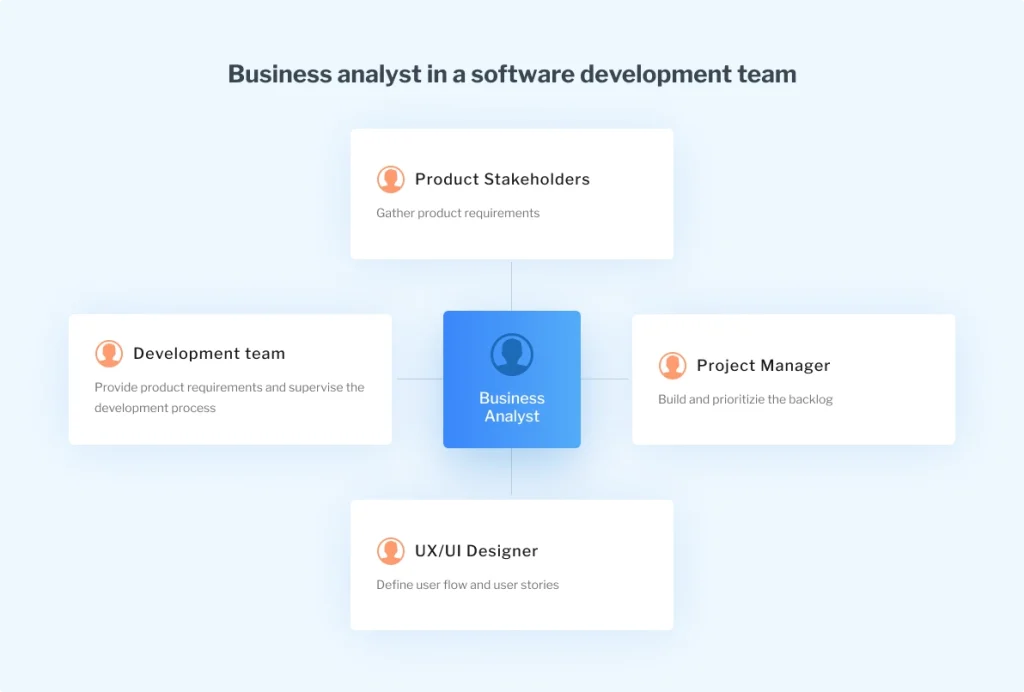We use cookies to ensure we give you the best experience on our website. By clicking Agree you accept our Privacy and Cookies Policy.
Business analyst: a leading player in your software development team

 14 minutes read
14 minutes read
Content
When it comes to everything digital, the dynamic nature of the market is beyond question. A single event can start a chain reaction that changes the whole game, shifting consumer needs, their daily habits, and the global economy itself. Companies that adapt to the ever-changing business environment and turn every opportunity into their advance are more likely to survive.
On this point, it’s absolutely necessary to hire someone who makes sure that project deliverables meet the exact business goals you need — someone like a business analyst.
What is the role of a business analyst on a software development project?
A business analyst is a core member of a software development team for many reasons. First of all, a BA investigates a business from an aerial perspective, identifying its pain points, needs and finding practical solutions. Furthermore, a business analyst establishes efficient communication, ensuring all members are looking in the same direction towards the same business goal.
Let’s take a look at the main responsibilities of a business analyst throughout the software development lifecycle.

Key responsibilities of a business analyst
A business analyst’s role has various responsibilities and tasks depending on the project phase. Engaging a business analyst right from the start of the software development lifecycle is crucial for on-time product launch and efficient resource allocation. That’s why you shouldn’t neglect the discovery phase — the work done on the pre-development stage directly affects your product’s cost and time-to-market.
Researching the field
The business analysis starts with getting well-oriented in the project domain and history and understanding the company’s inner workings. It’s also important to determine the project’s stakeholders since they’re the primary source of requirements. Stakeholders typically include customers, end-users, investors, and the company’s executives.
Clarifying the product’s concept & requirements
Business analysis activities include defining the ultimate idea of a product and its value for the company. To see the full picture, a business analyst interviews decision-makers and the product’s targeted audience. The process also involves setting up project milestones and definitions of “done” for each feature.
If the field research was done right, it lays the foundations for well-organized communication between all parties and ensures that requirements won’t change during the development. The requirements analysis process contributes to meeting user expectations and building the backbone of a project backlog.
Developing project documentation
After requirements are gathered and well-analyzed, a business analyst creates both technical and business documentation for a project. The amount and type of documentation vary from project to project, but the best practices recommend include at least some of the following types:
- User stories or use cases
- User personas
- Project road map
- Software Requirement Specifications (SRS)
- Design documentation (mind maps, wireframes, and prototypes)
- API documentation
- System architecture documentation
Some software development methodologies such as Agile reduce the amount of documentation and focus on direct face-to-face communication between the team and decision-makers. However, this approach often results in miscommunication and overtime work for designers and developers. By storing the whole project’s documentation in one place, a BA facilitates smooth workflow for the team and peace of mind for product owners.
Creating a project backlog
Using their business domain expertise and analytical skills, a business analyst can build an efficient and realistic project backlog. A project backlog requires prioritizing must-have and secondary features for delivering a fully-functioning MVP — the trick is finding a balance between getting fast ROI and creating a well-designed system.
A business analyst estimates what work needs to be done and how long it takes to implement every feature. Therefore, a business analyst takes part in resource allocation, finding ways to achieve the project’s goals while staying within the budget.
Supervising the development process
The business analyst’s duties aren’t limited to project discovery and planning. They include tracking the development process, translating product requirements to the team, and ensuring everything sticks to the plan. To keep in a loop with the daily workflow, a business analyst attends daily team meetings and backlog grooming prior to the next project milestone.
Business Analyst: More than a note-taker, a strategic architect
While often seen as the bridge between business and IT, a modern Business Analyst is fundamentally a strategic architect for your software product. We don’t just document what stakeholders say they want; we uncover what they truly need to achieve their business objectives and how a software solution can provide a tangible competitive advantage.
Our role begins long before a single line of code is written, delving deep into the “Why” before the “What” and “How.” This involves:
- Validating the business problem: Is the proposed software addressing a real, significant problem for the business or its users? We analyze the market, identify pain points, and assess the potential impact of a solution.
- Competitive landscape analysis: Understanding what your competitors offer is crucial. We analyze their features, user experience, strengths, and weaknesses to identify opportunities for differentiation and ensure your product can capture market share.
- Defining the product vision and strategy: Collaborating with stakeholders and Product Owners, we help shape a clear, compelling vision for the product, outlining its key goals, target audience, and how it will deliver value.
- Business model alignment: Software operates within a business context. We analyze and help refine the underlying business processes and models to ensure the software solution is not just functional but also supports efficient, value-generating operations.
By focusing on these strategic elements upfront, we help prevent building features that aren’t needed, ensure the final product is aligned with business goals, and pave the way for a higher return on investment.
Business Analyst’s footprint across the software development lifecycle (SDLC)
The Business Analyst’s involvement isn’t confined to the initial phase of a project. We are active participants throughout the entire Software Development Lifecycle, ensuring continuity, clarity, and value delivery from concept to launch and beyond.
- Inception/Discovery: This is where we lay the foundation. Activities include conducting in-depth stakeholder interviews and workshops, analyzing existing documentation and systems, performing market and competitor analysis, and defining the initial project scope and high-level requirements. Our key output often includes a Project Vision document, initial scope outline, and stakeholder maps.
- Planning: Working closely with Project Managers and the team, we help refine the scope, break down high-level requirements into more detailed features, contribute to effort estimation, and assist in creating the project roadmap and release plans.
- Execution (Development & QA): As development sprints are underway, BAs are indispensable for:
- Requirements Clarification: Answering developers’ and QAs’ questions regarding user stories, acceptance criteria, and business rules.
- Change management: Analyzing the impact of requested changes, prioritizing them, and updating documentation.
- Backlog refinement: Continuously grooming and prioritizing the product backlog with the Product Owner, ensuring the team always has a clear view of upcoming work.
- QA Support: Collaborating with Quality Assurance engineers to ensure test cases accurately reflect the business requirements and user needs.
- Deployment: While primarily a technical activity, BAs often support by preparing user documentation, conducting training sessions, and assisting with user acceptance testing (UAT) to ensure the deployed solution meets the defined requirements.
- Post-Launch/Evolution: The BA’s work continues as the product evolves. We gather user feedback, analyze usage data, identify new opportunities or issues, and define requirements for future iterations and enhancements. This is where we leverage insights from Business Analytics to drive continuous improvement.
Agile business analyst: Navigating complexity in iterative environments
In today’s fast-paced development landscape, Agile methodologies like Scrum and Kanban are prevalent. The Business Analyst plays a vital, though sometimes nuanced, role in Agile teams. We are not simply a hand-off point for requirements; we are integrated team members fostering collaboration and continuous value delivery.
- Partnering with the product owner: In many Agile setups, the BA works in close partnership with the Product Owner. While the PO typically owns the product vision and final prioritization, the BA often supports by:
- Conducting detailed analysis and research to inform the PO’s decisions.
- Breaking down large features into smaller, manageable User Stories.
- Writing clear, concise User Stories with well-defined Acceptance Criteria.
- Facilitating Backlog Refinement sessions.
- Facilitating team understanding: We act as the go-to person for the development team when they have questions about requirements or need further clarification on user needs and business rules.
- Embracing change: Agile thrives on adaptability. BAs in Agile environments must be comfortable with evolving requirements and skilled at managing change effectively within the iterative process.
- Focus on value delivery: Our constant focus is ensuring that each sprint delivers increments of working software that provide tangible business value to the users and stakeholders.
BA’s Toolkit: Techniques and deliverables
To effectively perform our role, we utilize a variety of techniques to elicit, analyze, document, and manage requirements. Some essential tools in a BA’s arsenal include:
- Requirements elicitation: Conducting structured interviews, facilitating workshops with diverse stakeholders, sending out targeted surveys, analyzing existing documentation, and observing users in their environment.
- Modeling and documentation: Creating Use Cases, writing User Stories and Acceptance Criteria, modeling business processes (e.g., BPMN diagrams), developing Data Models, creating Wireframes or Mockups (often in collaboration with UI/UX designers), and using Mind Maps for brainstorming and organizing information. Key documents can include Business Requirements Documents (BRD), Functional Specification Documents (FSD), or Product Backlogs in Agile tools.
- Analysis techniques: Performing SWOT analysis (Strengths, Weaknesses, Opportunities, Threats), PESTLE analysis (Political, Economic, Social, Technological, Legal, Environmental), Benchmarking against industry standards or competitors, and Value Stream Mapping to identify inefficiencies in processes.
These techniques help us gain a deep understanding of the problem domain, translate business needs into actionable requirements for the development team, and ensure everyone is aligned on the scope and goals.
Art of stakeholder management and communication
Effective communication is arguably the most critical skill for a Business Analyst. We are the central hub, translating between technical and business language and managing the expectations of a diverse group of stakeholders, including:
- Business users: Understanding their daily tasks, pain points, and needs.
- Subject matter experts (SMEs): Gathering detailed knowledge about specific business areas.
- Senior management/sponsors: Ensuring the project aligns with strategic objectives and communicating progress and value.
- Development team: Providing clear, concise, and readily available requirements and clarifications.
- Quality assurance (QA): Collaborating on test scenarios and acceptance criteria.
- External clients or partners: Managing requirements and expectations if the software is for external use.
Managing conflicting priorities, facilitating discussions, and building consensus among stakeholders is a significant part of the BA’s role. Strong negotiation and conflict resolution skills are invaluable here.
Beyond the surface: Different facets of business analysis
The term “Business Analyst” can encompass various specializations depending on the project and organization. While there’s significant overlap, some key areas include:
- IT business analyst: Focuses specifically on software and system requirements within IT projects.
- System analyst: Often has a more technical slant, focusing on the interaction between software systems and technical feasibility.
- Process analyst: Specializes in modeling, analyzing, and improving business processes, which is often a prerequisite for software development aimed at process automation or improvement.
Understanding these different focuses can help clarify the specific expectations of a BA role within a given context.

Business analyst’s essential skills
Business analysts come from different backgrounds, such as UX design, technical writing, quality assurance, software engineering, business consulting, and so on. Although tech proficiency varies from person to person, every business analyst should have the following skills.
Critical thinking
Unbiased fact analysis and qualitative/quantitative research are the two core qualities of every business analyst. Since a BA makes vital decisions that influence the pace of a project, their ability to process and evaluate information is critical.
Data visualization
A business analyst should be fluent in using modeling tools that visualize the system components or processes. UML and BPMN diagrams help communicate system architecture or internal business procedures with colleagues and project decision-makers. Furthermore, a business analyst assists UX designers in defining user flows and creating product mockups.
Finding practical solutions
A defined problem is half-solved, and a business analyst is the one who knows exactly how to frame and investigate complex issues. A high-qualified business analyst grasps the problem from multiple perspectives, including technology, business, and end-user. Problem-solving skills come hand in hand with the ability to collaborate with tech and non-tech experts from various fields.
Focusing on value
End-user satisfaction stands at the center of all planning, monitoring, and assessment affairs as an integral component of project success. By advocating for users’ needs throughout the product development lifecycle, a business analyst directly increases value for users and, as a result, for the business.
Project manager and business analyst: what’s the difference?
While the duties of a business analyst and a project manager overlap in many cases, there is a fundamental difference between these roles. A project manager makes sure all tasks are completed on schedule, resolves in-team personal and technical issues, and creates a strategy to prevent potential risks. A business analyst is concentrated on the inner processes of a company and the client’s expectations.
A project manager’s typical day includes checking-up with the team, assigning tasks, managing the workflow, meetings, and reporting. In contrast, a business analyst mostly contributes to project documentation. While a single person can combine these roles on a small project, bigger projects require hiring both a project manager and a business analyst to successfully launch the end-product.
Business analysis vs. business analytics
These terms are often used interchangeably, but they’re not quite the same. Business analysis is about understanding business’ and users’ needs and finding the most efficient ways to deliver value. Business analytics, or so-called data analytics, is more related to gathering and interpreting the data related to the product’s functions and performance.
Unlike business analysts, data analysts come into play after the product’s release. Using various business intelligence methods, they analyze how users interact with a product and provide actionable insights for product improvements.
When does business analysis make a difference?
Building a successful digital product requires more than just code and design. Even the most talented developers cannot figure out the stakeholders’ expectations and calculate the most effective solutions. Moreover, developers tend to continuously suggest technological improvements that are not always in line with the project’s budget or users’ needs.
Here we come to the two main benefits you get from business analysis — understanding customers’ needs and reducing the project’s costs. With meticulous requirements mining and a user-oriented approach, a business analyst anticipates decision turnarounds and enhances the product’s quality.
So, if you want to get the best out of software development and ensure your product aligns with the market demands, opt for business analysis services. At Blackthorn Vision, we transform your ideas into functional product design that helps you outshine the competition without overrunning the budget.
Quantifying the impact: Value Proposition of a Business Analyst
While not always directly tied to revenue, the impact of a skilled Business Analyst can be measured through various indicators that demonstrate value to the business:
- Reduced rework: Clear requirements and reduced misunderstandings lead to less time spent fixing issues that arise from ambiguity.
- Faster time to market: Streamlined requirements processes and clear communication accelerate the development cycle.
- Increased user adoption and satisfaction: Software that truly meets user needs is more likely to be adopted and lead to higher user satisfaction.
- Improved project success rates: Projects with dedicated business analysis are statistically more likely to be completed on time, within budget, and deliver the expected value.
- Optimized processes: Identifying and addressing inefficiencies in business processes through analysis leads to operational cost savings.
- Clearer scope and reduced scope creep: Well-defined requirements and change management processes help control scope and prevent costly expansions without proper evaluation.
Highlighting these tangible benefits reinforces the critical role of the Business Analyst as an investment that pays significant dividends in the success of software development initiatives.







































































